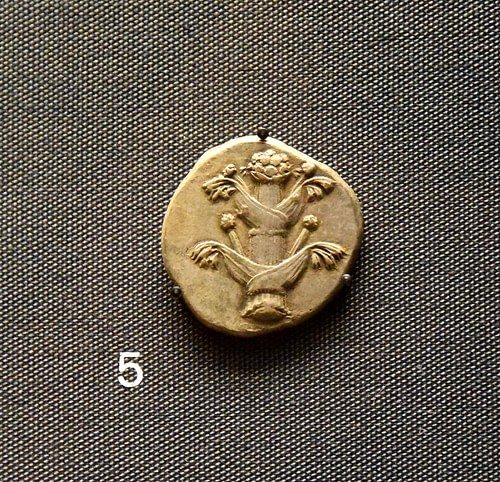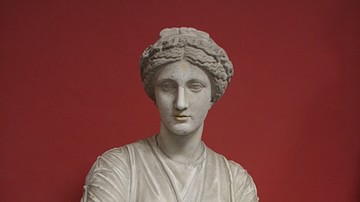The silphium plant of Cyrene, valued as a seasoning, aromatic, and for its medicinal properties, is referenced by several notable ancient writers, but two of the best-known descriptions come from Theophrastus (l. c. 371 to c. 287 BCE) and Pliny the Elder (l. 23-79 CE). By Pliny's time, silphium was extinct, most likely due to overharvesting and overgrazing.

Among the many other writers who addressed silphium are Herodotus (l. c. 484 to 425/413 BCE), Hippocrates (l. c. 460 to c. 379 BCE), Strabo (l. c. 64 BCE to c. 24 CE), Aulus Cornelius Celsus (l. c. 25 BCE to c. 50 CE), Dioscorides (l. 1st century CE), Soranus of Ephesus (l. 1st century CE), Pausanias (l. 110-180 CE), Arrian (l. c. 86 to c. 160 CE), and Galen (l. 129-216 CE), to name only a few of the most famous. Later writers, such as Galen, are thought to be referencing the asafoetida plant in their works when they mention "silphium." The asafoetida is a species of Ferula and related to silphium but, according to Pliny (if he is actually referencing asafoetida in chapter 15), this was grown in Persia, Media, and Armenia and was inferior to the plant from Cyrene.
Silphium seems to have been regarded as a cure-all by the Mediterranean civilizations from c. 631 BCE when Cyrene was founded in North Africa as a colony of Thera (modern Santorini) until the 1st century CE when Pliny the Elder claims it had become extinct. In addition to its medicinal properties, seasoning, and aromatic uses, silphium was also valued as a contraceptive and, according to some scholars, as an aphrodisiac.
The plant grew wild in Cyrenaica (the region around Cyrene, modern-day Shahhat, Libya), and its export made Cyrene and its satellite cities among the wealthiest in the Mediterranean. After Rome assumed control of Cyrenaica in 96 BCE, overharvesting of the plant to meet the high demand, as well as overgrazing of sheep in the narrow area where silphium grew wild, led to its extinction. As both Theophrastus and Pliny note, the plant resisted cultivation and so, once the resources of its natural environment were exhausted, it could not be reproduced elsewhere. The loss of silphium is believed to be the first human-induced species extinction in history.
Text
The following passages come from Theophrastus' Enquiry into Plants (the first two sections given in abbreviated form due to space considerations) and Pliny the Elder's Natural History. Theophrastus (the "Father of Botany"), friend and successor to Aristotle (l. 384-322 BCE), catalogued the plant life of his time extensively, while Pliny the Elder's Natural History sought to provide a comprehensive distillation of world knowledge at the time, including information on plants. Most works on silphium in the modern era rely on the following passages for a description of the plant, how it was harvested, and why it may have become extinct.
From Theophrastus:
3.1.7 But this kind of generation is somehow beyond the ken of our senses. There are other admitted and observable kinds, as when a river in flood gets over its banks or has altogether changed its course, even as the Nesos in the district of Abdera often alters its course, and in so doing causes such a growth of forest in that region that by the third year it casts a thick shade. The same result ensues when heavy rains prevail for a long time; during these too many plants shoot up... Again, in some places they say that after rain a more singular abundance of vegetation has been known to spring up; for instance, at Cyrene, after a heavy pitchy shower had fallen: for it was under these circumstances that there sprang up the wood which is near the town, though till then it did not exist. They say also that silphium has been known to appear from some such cause, where there was none before. Such are the ways in which these kinds of generation come about.
3.2.1 All trees are either fruit-bearing or without fruit, either evergreen or deciduous, either flowering or flowerless; for certain distinctions apply to all trees alike, whether cultivated or wild... And the rule also does not hold good of anything which does not admit of cultivation, whether it be a tree or one of the smaller plants, as silphium caper and, among leguminous plants, the lupin; these one might say are specially wild in their character. For, as with animals which do not submit to domestication, so a plant which does not submit to cultivation may be called wild in its essential character. However Hippon declares that of every plant there exists both a cultivated and a wild form, and that 'cultivated' simply means that the plant has received attention, while 'wild' means that it has not; but though he is partly right, he is partly wrong. It is true that any plant deteriorates by neglect and so becomes wild; but it is not true that every plant may be improved by attention, as has been said. Wherefore we must make our distinction and call some things wild, others cultivated – the latter class corresponding to those animals which live with man and can be tamed.
6.3.1 Most important and peculiar in their characters are the silphium and papyrus of Egypt. These too come under the class of ferula-like plants; of these we have spoken of the papyrus already under the head of plants living in water; of the other we have now to speak.
6.3.2 The silphium has a great deal of thick root; its stalk is like ferula in size, and is nearly as thick; the leaf, which they call inaspeton, is like celery: it has a broad fruit, which is leaf-like, as it were, and is called the phyllon. The stalk lasts only a year, like that of ferula. Now in spring it sends up this maspelon, which purges sheep and greatly fattens them, and makes their flesh wonderfully delicious; after that it sends up a stalk, which is eaten, it is said, in all ways, boiled and roast, and this too, they say, purges the body in forty days. It has two kinds of juice, one from the stalk and one from the root; wherefore the one is called 'stalk-juice,' the other 'root-juice.' The root has a black bark, which is stripped off. They have regulations, like those in use in mines, for cutting the root, in accordance with which they fix carefully the proper amount to be cut, having regard to previous cuttings and the supply of the plant. For it is not allowed to cut it wrong nor to cut more than the appointed amount; for, if the juice is kept and not used, it goes bad and decays. When they are conveying it to Peiraeus, they deal with it thus: having put it in vessels and mixed meal with it, they shake it for a considerable time, and from this process it gets its colour, and this treatment makes it thenceforward keep without decaying. Such are the facts in regard to the cutting and treatment. The plant is found over a wide tract of Libya, for a distance, they say, of more than four thousand furlongs, but it is most abundant near the Syrtis, starting from the Euesperides islands. It is a peculiarity of it that it avoids cultivated ground, and, as the land is brought under cultivation and tamed, it retires, plainly shewing that it needs no tendance but is a wild thing. The people of Cyrene say that the silphium appeared seven years before they founded their city; now they had lived there for about three hundred years before the archonship at Athens of Simonides.
6.3.3 Such is their account. Others however say that the root of the silphium grows to the length of a cubit or a little longer, and in the middle of this is a head, which is the highest part and almost comes above ground, and is called the 'milk', from this then presently grows the stalk, and from that the magydaris which is also called the phyllon; but it is really the seed, and, when a strong south wind blows after the setting of the dog-star, it is scattered abroad and the silphium grows from it. The root and the stalk grow in the same year; nor is this a singular feature unless they mean that it grows immediately after the dispersal of the seed since the same thing occurs with other plants also.
6.3.4 There is this singular statement, which is inconsistent with what was said above, that, it is said, it is necessary to dig the ground every year, and that, if it be left alone, it bears the seed and the stalk, but these are inferior and so is the root; on the other hand, that with digging they are improved because the soil is changed. (This is inconsistent with the statement that silphium avoids cultivated land.) They add that the roots are cut up into vinegar and eaten fresh, and that the leaf is of a golden colour. We have also the inconsistent statement that sheep are not purged by eating the leaves; for they say that in spring and in winter they are driven into the hill-country, where they feed on this and on another plant which is like southernwood; both these plants appear to be heating and not to cause purging, but, on the contrary, to have a drying effect and promote digestion. It is also said that, if a sheep which is sick or in bad condition comes to that district, it is quickly cured or else dies, but usually it recovers. Which of these accounts is true is matter for enquiry.
6.3.5 The plant called magydaris is distinct from silphium, being of later growth and less pungent, and it does not produce the characteristic juice; experts can also easily distinguish it by its appearance. It grows in Syria and not in Cyrene, and they say that it is also abundant on Mount Parnassus, and some call it silphium. Whether however, like silphium, it avoids cultivated ground is matter for enquiry, as also whether it has any resemblance or likeness in leaf and stalk, and, in general, whether it produces a juice. In these examples we may consider the class of ferula-like plants [and, in general, that of spinous plants.]

From Pliny the Elder:
Chapter 15: Next to these [other plants], laserpitium claims our notice, a very remarkable plant, known to the Greeks by the name of "silphium," and originally a native of the province of Cyrenaica. The juice of this plant is called "laser," and it is greatly in vogue for medicinal as well as other purposes, being sold at the same rate as silver. For these many years past, however, it has not been found in Cyrenaica, as the farmers of the revenue who hold the lands there on lease, have a notion that it is more profitable to depasture flocks of sheep upon them. Within the memory of the present generation, a single stalk is all that has ever been found there, and that was sent as a curiosity to the Emperor Nero. If it so happen that one of the flock, while grazing, meets with a growing shoot of it, the fact is easily ascertained by the following signs; the sheep, after eating of it, immediately falls asleep, while the goat is seized with a fit of sneezing. For this long time past, there has been no other laser imported into this country, but that produced in either Persis, Media, or Armenia, where it grows in considerable abundance, though much inferior to that of Cyrenaica; and even then it is extensively adulterated with gum, sacopenium, or pounded beans. I ought the less then to omit the facts, that in the consulship of C. Valerius and M. Herennius, there was brought to Rome, from Cyrene, for the public service, thirty pounds' weight of laserpitium, and that the Dictator Cæsar, at the beginning of the Civil War, took from out of the public treasury, besides gold and silver, no less than fifteen hundred pounds of laserpitium.
We find it stated by the most trustworthy among the Greek writers, that this plant first made its appearance in the vicinity of the gardens of the Hesperides and the Greater Syrtis, immediately after the earth had been soaked on a sudden by a shower as black as pitch. This took place seven years before the foundation of the city of Cyrene, and in the year of Rome 143. The virtues of this remarkable fall of rain extended, it is said, over no less than four thousand stadia of the African territory; and upon this soil laserpitium began universally to grow, a plant that is in general wild and stubborn, and which, if attempted to be cultivated, will leave the spot where it has been sown quite desolate and barren. The roots of it are numerous and thick, the stalk being like that of fennel-giant, and of similar thickness. The leaves of this plant were known as "maspetum," and bore a considerable resemblance to parsley; the seeds of it were foliaceous, and the plant shed its leaves every year. They used to feed the cattle there upon it; at first it purged them, but afterwards they would grow fat, the flesh being improved in flavour in a most surprising degree. After the fall of the leaf, the people themselves were in the habit of eating the stalk, either roasted or boiled: from the drastic effects of this diet the body was purged for the first forty days, all vicious humours being effectually removed.
The juices of this plant were collected two different ways, either from the root or from the stalk; in consequence of which these two varieties of the juice were known by the distinguishing names of "rhizias" and "caulias," the last being of inferior quality to the other, and very apt to turn putrid. Upon the root there was a black bark, which was extensively employed for the purposes of adulteration. The juice of the plant was received in vessels and mixed there with a layer of bran; after which, from time to time it was shaken, till it had reached a proper state of maturity; indeed, if this precaution was neglected, it was apt to turn putrid. The signs that it had come to maturity were its colour, its dryness, and the absorption of all humidity.
There are some authors, however, who state that the root of laserpitium was more than a cubit in length, and that it presented a tuberosity above the surface of the earth. An incision, they say, was made in this tuberosity, from which a juice would flow, like milk in appearance; above the tuberosity grew a stalk, to which they give the name of "magydaris;" the leaves that grew upon this stalk were of the colour of gold, and, falling at the rising of the Dog-star, when the south winds begin to prevail, they acted as seed for the purposes of reproduction. It was from these leaves, too, they say, that laserpitium was produced, the root and the stalk attaining their full growth in the space of one year. The same writers also state, that it was the practice to turn up the ground about the plant, and that it had no such effect as purging the cattle that were fed upon it; though one result of using it as food was, that such cattle as were ailing were either cured of their distempers, or else died immediately upon eating of it, a thing, however, that but rarely happened. The first description, however, is found to agree more nearly with the silphium that comes from Persis.
Chapter 16: There is another variety of this plant, known as "magydaris," of a more delicate nature, less active in its effects, and destitute of juice. It grows in the countries adjacent to Syria but is not to be found in the regions of Cyrenaica. There grows also upon Mount Parnassus, in great abundance, a plant to which some persons give the name of "laserpitium:" by means of all these varieties, adulterations are effected of a production that is held in the highest esteem for its salutary qualities and its general usefulness. The chief proofs of its genuineness consist in its colour, which ought to be slightly red without, and when broken quite white and transparent within; the drops of it, too, should melt very rapidly on the application of spittle. It is extensively employed for medicinal purpose.





